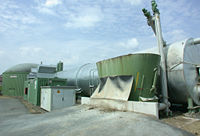
Photo from wikipedia
Recently, simultaneous sulfide removal and bioenergy production by microalgal treatment have attracted growing attention. However, the response of nitrogen metabolism to the sulfide-removal process has yet to be explored. Here,… Click to show full abstract
Recently, simultaneous sulfide removal and bioenergy production by microalgal treatment have attracted growing attention. However, the response of nitrogen metabolism to the sulfide-removal process has yet to be explored. Here, variable levels of sulfide could be completely removed by Chlamydomonas sp. Tai-03 under both high and low nitrate conditions in synthetic wastewaters. The highest sulfide removal rate of 5.56 mg-S L-1 h-1 was achieved with the addition of 100 mg L-1 sulfide in the presence of high nitrate. Meanwhile, sulfide was chemically oxidized to sulfate and then ingested by microalgae. Interestingly, sulfide-removal efficiency critically depended on nitrate concentration. Sulfide can also enhance the ability of microalgae to assimilate nitrogen. Based on the analysis of sulfur- and nitrogen-related metabolic profiling, serine as a precursor decreased by 94 % under low levels of nitrate, which induced the significant inhibition of cysteine and methionine biosynthesis. The results indicated that nitrogen source played a critical role in the sulfur cycle because of the positive relationship between the aforementioned metabolic processes and nitrate concentration. Additionally, sulfide can improve lipid and carbohydrate productivity under high levels of nitrate. This study enhances our understanding of the mechanisms underlying the simultaneous removal of sulfide and alternative bioenergy production.
Journal Title: Journal of hazardous materials
Year Published: 2020
Link to full text (if available)
Share on Social Media: Sign Up to like & get
recommendations!